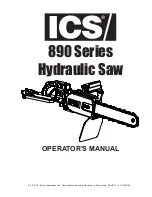
- 9 -
g
!
!
WARNING! The jigsaw has a special blade that makes it suita-
ble for cutting wood, plastic, pipes or sheet metal with low carbon
content, aluminium profiles, plasterboard and bricks. Any other
use is prohibited.
These instructions contain information deemed necessary for correct
use, knowledge and standard tool maintenance. They do not report
information on techniques for working with various materials. The
user will find more information in books and specialised publications
or by attending courses.
SYMBOLS
Carefully observe the symbols in
fig. B
and memorise their respective
meanings. Correct interpretation of the symbols allows safer use of
the machine.
1. Machine model, technical data
2. Warning!
3. Carefully read the instructions before use
4. EC certification marking
5. manufacturing batch number. The first 2 figures of the batch number
indicate the year of manufacture
V Volt
Hz Hertz
~
Alternating current
Direct current
A Ampere
W Watt
kg Kilograms
nO
No load speed
mm Millimetres
s Seconds
h Hours
min-1 Revolutions per minute
dB Decibel
°C
Degrees centigrade
Li-Ion Lithium ions
Wh Watt-hours
COMPONENTS
Refer to
fig. A
and the other figures attached to these instructions.
1. On/off switch with speed adjustment
3. Handgrip
4. Switch safety button
5. Adjustable base plate
6. Blade
7. Blade chuck
8. Guard
9. Sawblade guide
10. Screws and base lock plate
11. Motor air vents
13. Battery compartment
14. Key
15. Pendulum action lever
16. Parallel guide
17. Screws and parallel guide locking knob
18. Quick blade coupling lever
INSTALLATION
!
!
WARNING! The manufacturer is not liable for any direct and/or
indirect damage caused by incorrect connections.
!
!
WARNING! Before carrying out the following operations, make
sure that the battery is disconnected from the tool.
!
!
WARNING! Wear protective gloves.
TRANSPORT
Always remove the blade and use the packaging or case (where provi-
ded) when transporting the tool; this will protect it from impact, dust
and humidity which can compromise normal operation.
HANDLING
Firmly grip both handgrips without operating the switch; keep the tool
well away from your body and, after using, place it down gently.
SWITCHING ON
When choosing where to use the power tool, the following should be
considered:
- that the place is not damp and is protected from the weather
- that there is a large working area free from obstacles
- that there is good lighting
- that the premises are well ventilated or equipped with a forced air
extraction system to eliminate cutting waste dispersed into the air
- that it is used close to the main switch with residual current device
- that the power supply system is earthed and conforms to the stan-
dards (only if the power tool is class I, which is equipped with an
earth cable plug)
- that the room temperature is between 10° and 35°C
- that the environment is not in a flammable/explosive atmosphere
Take out the machine and its components and visually check that they
are perfectly intact; then proceed to thoroughly clean them.
CHARGING THE BATTERY (Follow the instructions attached to the
battery charger)
!
!
WARNING! Before using the drill it is necessary to fully charge
the battery.
!
!
WARNING! Recharge only with a battery charger designed for
this type of tool. An inappropriate battery charger can cause a fire
hazard when used with other battery units.
To keep the battery in good working order, do not discharge it
completely.
Fully charge the battery:
- After each use.
- At least every 4 months, even if not used.
- If while working you notice a clear drop in the performance of the tool.
The factors that influence the battery’s lifetime are:
- number of charge/discharge cycles, stress from heavy use
- time since it was manufactured, lack of maintenance
- lack of recharging
- staying at temperatures above 20°C.
INSERTING AND REMOVING THE BATTERY (fig. C)
- Insert the battery through the guides in the battery compartment. (pos.13)
- Take out the battery from its housing in the tool by operating the release
device (pos.19)
The machine may be supplied with some loose components. For their
assembly, observe the following instructions.
MOUNTING AND REPLACING THE BLADE (fig. D)
!
!
WARNING! remove the battery before inserting or replacing
the blade.
!
!
WARNING! The cutting parts can cause serious injuries – use
protective gloves!
!
!
WARNING! Do not turn on the start-up switch during the assembly
operations.
!
!
WARNING! The assembly of the blade must be carried out with
absolute precision. Incorrect assembly causes danger.






























